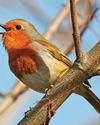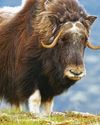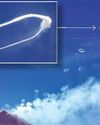
FUSTY FEET
The same bacteria used to ripen strongsmelling cheeses are also found on stinky feet.
Take a sniff - what do you smell? Perhaps Tit's some delicious dinner cooking, freshly cut grass or fragrant flowers. You might also catch a whiff of your pet pooch's pongy poo, your dad's terrible trumps, or even your sibling's stinky feet. Ewwwwww! Stinky smells can strike at any time and, thanks to evolution (the process by which living things develop), your nose knows when it smells something bad.
There's no shortage of nasty niffs out there.Animals use their stench for lots of different reasons. Skunks squirt an unpleasant liquid when they feel threatened, bears rub their scent on trees to mark their territory, and male musk oxen give off a strong pong to attract females. Humans are no better, with our armpits, cheesy feet and bad bums, but why do certain odours smell so horrid anyway? Let's get to the bottom of this stinky science and find out why it's important for survival?
What is smell?
The parts of your body responsible for your sense of smell are called the olfactory system. It evolved around 700 million years ago in fishy creatures called lancelets. These creatures are the most distantly related animals that share similar olfactory (smell) genes to humans. Genes are coded sequences of DNA, a chemical that carries all the information about a species. They contain the instructions for how an individual creature develops and grows. Lancelets had about 40 genes relating to smell (humans have about 390) and may have been able to turn their whole body into a nose to pick up scents in the water surrounding them. This eventually evolved into the system you have today, but how does it work?
This story is from the Issue 74 edition of The Week Junior Science+Nature UK.
Start your 7-day Magzter GOLD free trial to access thousands of curated premium stories, and 8,500+ magazines and newspapers.
Already a subscriber ? Sign In
This story is from the Issue 74 edition of The Week Junior Science+Nature UK.
Start your 7-day Magzter GOLD free trial to access thousands of curated premium stories, and 8,500+ magazines and newspapers.
Already a subscriber? Sign In

SUGAR RUSH
Join the candy craze as Claire Karwowski studies the sugary science of sweets.

Wildlife watch
Stevie Derrick shows you what to spot in nature this month

The Sixth Sense
Could humans have more than five senses?

Catherine Heymans
Meet the starry-eyed astronomer who loves backyard stargazing.

WORLD OF WHIFFS
Stevie Derrick follows her nose to track down the world's grossest stinks and nastiest niffs.

Dogs can understand names of objects
Humans enjoy talking to their dogs. If you have a four-legged friend of your own, you might have taught them to respond to commands like \"sit\" and \"stay\".

Smoke rings in the sky
In April, videos were filmed of Mount Etna, a volcano on the Italian island of Sicily, puffing what looked like smoke rings into the sky.

Huge gold nugget found
A gold nugget that could be the largest ever found in England was recently put up for auction. Metal detectorist Richard Brock discovered the nugget on farmland during an organised expedition in Shropshire last year.

Evolutionary tree shows birds in a new light
Researchers have produced the most detailed evolutionary tree of birds ever.

The largest plane to ever fly
Take a first look at the mighty Radia WindRunner aircraft